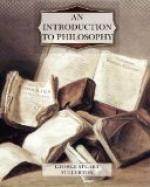The material universe may, for aught we know, be limited in extent. The actual space relations in which things stand to each other may not be limitless. But these actual space relations taken alone do not constitute space. Men have often asked themselves whether they should conceive of the universe as limited and surrounded by void space. It is not nonsense to speak of such a state of things. It would, indeed, appear to be nonsense to say that, if the universe is limited, it does not lie in void space. What can we mean by void space but the system of possible relations in which things, if they exist, must stand? To say that, beyond a certain point, no further relations are possible, seems absurd.
Hence, when a man has come to understand what we have a right to mean by space, it does not imply a boundless conceit on his part to hazard the statement that space is infinite. When he has said this, he has said very little. What shall we say to the statement that space is infinitely divisible?
To understand the significance of this statement we must come back to the distinction between appearances and the real things for which they stand as signs, the distinction discussed at length in the last chapter.
When I see a tree from a distance, the visual experience which I have is, as we have seen, not an indivisible unit, but is a complex experience; it has parts, and these parts are related to each other; in other words, it has both “matter” and “form.” It is, however, one thing to say that this experience has parts, and it is another to say that it has an infinite number of parts. No man is conscious of perceiving an infinite number of parts in the patch of color which represents to him a tree at a distance; to say that it is constituted of such strikes us in our moments of sober reflection as a monstrous statement.
Now, this visual experience is to us the sign of the reality, the real tree; it is not taken as the tree itself. When we speak of the size, the shape, the number of parts, of the tree, we do not have in mind the size, the shape, the number of parts, of just this experience. We pass from the sign to the thing signified, and we may lay our hand upon this thing, thus gaining a direct experience of the size and shape of the touch object.
We must recognize, however, that just as no man is conscious of an infinite number of parts in what he sees, so no man is conscious of an infinite number of parts in what he touches. He who tells me that, when I pass my finger along my paper cutter, what I perceive has an infinite number of parts, tells me what seems palpably untrue. When an object is very small, I can see it, and I cannot see that it is composed of parts; similarly, when an object is very small, I can feel it with my finger, but I cannot distinguish its parts by the sense of touch. There seem to be limits beyond which I cannot go in either case.




